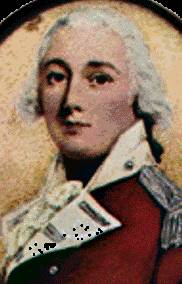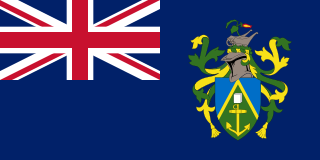
The Pitcairn Islands, officially Pitcairn, Henderson, Ducie and Oeno Islands, are a group of four volcanic islands in the southern Pacific Ocean that form the sole British Overseas Territory in the South Pacific. The four islands – Pitcairn proper, Henderson, Ducie, and Oeno – are scattered across several hundred miles of ocean and have a combined land area of about 47 square kilometres (18 sq mi). Henderson Island accounts for 86% of the land area, but only Pitcairn Island is inhabited. The nearest places are Mangareva to the west and Easter Island to the east.

The Pitcairn Islands consist of four islands: Pitcairn Island, Oeno Island, Henderson Island and Ducie Island:
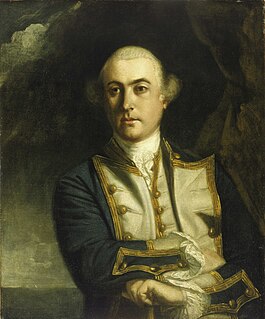
Vice-Admiral The Hon. John Byron was a British Royal Navy officer and politician. He was known as Foul-weather Jack because of his frequent encounters with bad weather at sea. As a midshipman, he sailed in the squadron under George Anson on his voyage around the world, though Byron made it only to southern Chile, where his ship was wrecked. He returned to England with the captain of HMS Wager. He was governor of Newfoundland following Hugh Palliser, who left in 1768. He circumnavigated the world as a commodore with his own squadron in 1764-1766. He fought in battles in The Seven Years' War and the American Revolution. He rose to Vice Admiral of the White before his death in 1786.

Admiral Thomas Cochrane, 10th Earl of Dundonald, Marquess of Maranhão, GCB, ODM, OSC, styled Lord Cochrane between 1778 and 1831, was a British naval flag officer of the Royal Navy, mercenary and radical politician. He was a daring and successful captain of the Napoleonic Wars, leading Napoleon to nickname him Le Loup des Mers. He was successful in virtually all his naval actions.
The year 1767 in science and technology involved some significant events.

Fletcher Christian was master's mate on board HMS Bounty during Lieutenant William Bligh's voyage to Tahiti during 1787–1789 for breadfruit plants. In the mutiny on the Bounty, Christian seized command of the ship from Bligh on 28 April 1789.

Sir Alexander Inglis Cochrane GCB RN was a senior Royal Navy commander during the Napoleonic Wars and achieved the rank of Admiral. He was knighted for his service.
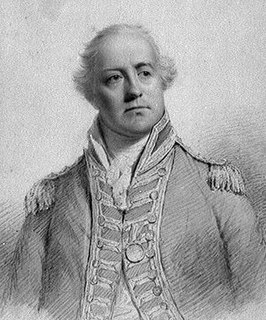
Admiral of the Fleet James Gambier, 1st Baron Gambier, was a Royal Navy officer. After seeing action at the capture of Charleston during the American Revolutionary War, he saw action again, as captain of the third-rate HMS Defence, at the battle of the Glorious First of June in 1794, during the French Revolutionary Wars, gaining the distinction of commanding the first ship to break through the enemy line.

Samuel Wallis was a British naval officer and explorer of the Pacific Ocean.

Philip Carteret, Seigneur of Trinity was a British naval officer and explorer who participated in two of the Royal Navy's circumnavigation expeditions in 1764–66 and 1766–69.

HMS Dolphin was a 24-gun sixth-rate frigate of the Royal Navy. Launched in 1751, she was used as a survey ship from 1764 and made two circumnavigations of the world under the successive commands of John Byron and Samuel Wallis. She was the first ship to circumnavigate the world twice. She remained in service until she was paid off in September 1776, and she was broken up in early 1777.
Events from the year 1767 in Great Britain.

Boudeuse was a 26-gun, 12-pounder-armed sailing frigates named La Boudeuse on 6 June 1765. She is most famous for being the exploration ship of Louis Antoine de Bougainville between 1766 and 1769. She also served in the American and French Revolutionary Wars, during which she captured two enemy vessels. She was broken up for firewood at Malta in early 1800.
Pitcairn Islanders also referred to as Pitkerners, are the inhabitants or citizens of the Pitcairn Islands. The Pitcairn Islands is a nation, mainly inhabited by Euronesians of British and Tahitian descent. The culture held in common by most Pitcairn Islanders is mainstream Pitcairn culture, a mixture of British and Polynesian culture derived from the traditions of the settlers who landed in 1790. Most of the people today are descended from the HMS Bounty mutineers of English, Cornish, Manx, Scottish descent and the Tahitian companions, including the few who settled afterwards. As of 2018, there are a total of 50 people inhabiting the island.
Thirty-nine vessels of the Royal Navy and its predecessors have borne the name Swallow, as has one dockyard craft, one naval vessel of the British East India Company, and at least two revenue cutters, all after the bird, the Swallow:
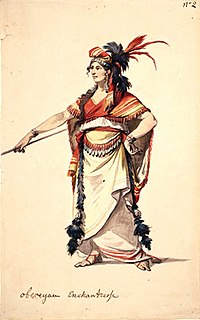
Purea, Tevahine-'ai-roro-atua-i-Ahurai, also called Oborea, was a queen from the Landward Teva tribe and a self-proclaimed ruler of all Tahiti. Queen Purea is known from the first famous European expeditions to Tahiti. She ruled as chieftainess of her tribe area in 1767-1768, when she was encountered by the expedition of Samuel Wallis.
Captain Archibald Cochrane was a Royal Navy officer of the early nineteenth century, who served in the Napoleonic Wars. His most noticeable activity came early in his career when he was employed as a midshipman aboard his brother, Commander Thomas Cochrane's ship HMS Speedy. Aboard Speedy, Cochrane participated in the engagement and capture of the Spanish frigate Gamo, which was more than three times the size of the British ship. Although captured by the French shortly afterwards, Cochrane's career continued successfully and he was promoted to lieutenant in 1804, sailing to the East Indies on HMS Victor and rapidly gaining promotion to post captain in the frigate HMS Fox. In 1811, Cochrane returned to Europe and did not serve again, retiring to Sunderland and dying in 1829.

The Bounty Bible is a Bible that is thought to have been used on HMS Bounty, the ship famed for the Mutiny on the Bounty.
Matavai Bay is a bay on the north coast of Tahiti, the largest island in the Windward group of French Polynesia. It is in the commune of Mahina, approximately 8 km east of the capital Pape'ete.


